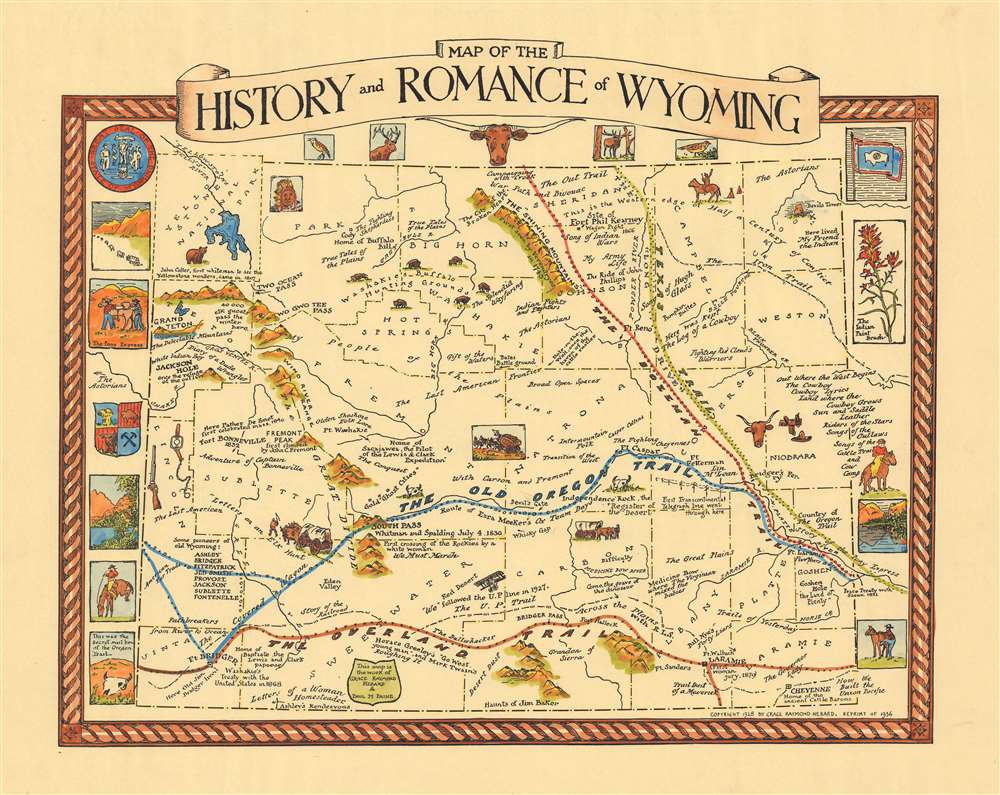This item has been sold, but you can get on the Waitlist to be notified if another example becomes available, or purchase a digital scan.
1936 Grace Hebard Pictorial Map of Wyoming
HistoryRomanceWyoming-hebard-1936
Title
1936 (dated) 14 x 17.25 in (35.56 x 43.815 cm)
Description
Publication History and Census
This map was drawn by Grace Raymond Hebard and Paul M. Paine and published by Grace Raymond Hebard in 1936. A previous edition was published in 1928. Nine examples of this map are cataloged in OCLC and are part of the institutional collections at the Wisconsin Historical Society, Southern Illinois University, the State Historical Society of South Dakota State Archives, the Denver Public Library, the University of Wyoming, the Buffalo Bill Center of the West, Montana State University, Brigham Young University, and the University of Washington.CartographerS
Grace Raymond Hebard (July 2, 1861 - October 11, 1936) was an American historian, political economist, author, suffragist, and professor. Born in Clinton, Iowa, Hebard's father died when she was nine years old. Her mother wanted her and her siblings to receive a college education, so she moved the family to Iowa City, where she purchased a house and rented out half of it as a course of income. Hebard, a sickly child, only attended public school for two years and was homeschooled by her mother for the rest of her education. She entered the State University of Iowa as the only woman in the engineering department. Her studies focused on surveying and mechanical drawing and she graduated with a Bachelor of Science degree in 1882. Not long after graduation, Heard fo8und a job in Cheyenne, Wyoming working for the United States Surveyor General's office. The entire family moved with Hebard to Cheyenne. Hebard worked at the Surveyor General's office until 1889, when the surveying and mapping of the Wyoming Territory was finished. During those years, Hebard took correspondence courses earned a Master of Arts degree from the State University of Iowa, which, intriguingly, did not have a graduate school until 1900, although the school's records indicate Hebard received her Master of Arts degree in 1885. Hebard received an appointment to the University of Wyoming Board of Trustees in January 1891 in large part due to her connections with powerful Wyoming families and her brother's election to the territorial assembly. When she left for Laramie, she became the first person in her family to leave home. She also began a forty-five-year career at the University of Wyoming. She worked as the board's paid secretary and was responsible for producing the meeting minutes. Since she lived in Laramie and six other board members did not, Hebard served as part of the executive committee that oversaw the university's day-to-day activities. Hebard completed correspondence courses in political economy from Illinois Wesleyan University and received her Ph.D. in 1894. She taught a correspondence course in constitutional history during the 1893-94 academic year and also became the secretary for the correspondence school and the agricultural extension school. Hebard was named an associate professor of political economy in 1906. The current political economy professor, Herbert Quaintance, objected to her appointment, and was forced out of the university because of it. Hebard was then given his job and was named head of the Department of Political Economy and Sociology. After being given this position, Hebard truly began to make a name for herself as an historian and focused on the history of the American West with a specific focus on Wyoming. She was a prolific writer and published books about various topics, including the Bozeman Trail, Sacagawea, Shoshone Chief Washakie, and the Oglala Sioux war leader Red Cloud. Even though she was a respected historian, it was apparent that Hebard tended to seek out facts that supported her preconceived ideas. She was a meticulous researcher, but would ignore facts that did not fit into the narrative she wanted to put forward. Even her personal papers, which are housed at the University of Wyoming, make it apparent that she would ignore inconvenient facts and that her work contradicted that of other distinguished historians. Nonetheless, several of her books, including those about Sacagawea and Red Cloud, are still in print today. More by this mapmaker...
Paul Mayo Paine (January 13, 1869 - July 4, 1955) was an American newspaperman, librarian, and educator. Born in Troy, Pennsylvania, Paine graduated from Lehigh University in 1891 with a degree in civil engineering. After graduating, Paine worked for the Pennsylvania Railroad for two years before joining the staff of a Philadelphia newspaper. He then moved on to the Syracuse Post 1894, but took a leave of absence to serve in the 203rd Infantry Division as a sergeant during the Spanish-American War. After the war he returned to the Post and then served as the assistant librarian at the Syracuse Public Library. He was appointed the head library of the library in 1915. At one point he served as the president of the New York State Library Association. Paine worked for the Syracuse Public Library until he retired in 1942. He spent a summer working in Charleston, South Carolina during World War I organizing camp libraries for servicemen. Over the course of his life Paine received two honorary degrees, a Master of Arts degree from Lehigh University and a Doctor of Letters from Syracuse University. He also worked as a professor in the College of Journalism at Syracuse University for a number of years. Paine is also remembered for drawing and publishing a series of maps celebrating locations in fiction books as well as historical events. Learn More...

